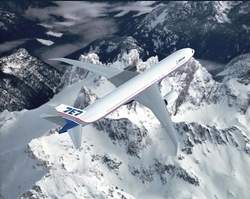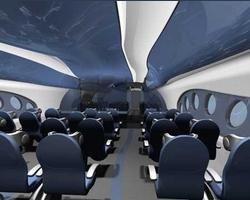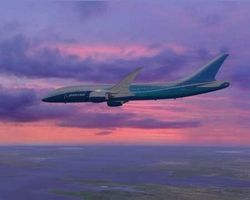...Other Than the Fact That Polls Shouldn't Name Airliner
Designs
Mike Bair, senior vice president of the Boeing 7E7 program, said
today that the company is making excellent progress on the
development of the 7E7 and continues to be on track to seek
authority to offer the airplane later this year.
 During a presentation at the Paris Air Show, Bair
announced the airframe candidate companies that have been selected
to participate in the design and manufacture of large
subassemblies.
During a presentation at the Paris Air Show, Bair
announced the airframe candidate companies that have been selected
to participate in the design and manufacture of large
subassemblies.
Lots of Parts... Lots of Outsourcing
Alenia Aeronautica, Fuji Heavy Industries, Kawasaki Heavy
Industries, Mitsubishi Heavy Industries and Vought Aircraft
Industries have been selected as external candidates. In addition,
several Boeing sites will be participating at this level.
"We are not at a point where we can say specifically what parts
or what percentage of the airplane will be awarded to any company,"
Bair emphasized. "Our talks are ongoing. However, these companies
have distinguished themselves as the candidates for receiving
design-and-build work for the 7E7 airframe."
 Bair
noted that other companies that participated in the materials
technology development effort will likely become suppliers to the
program by working with one or more of the main team members.
Bair
noted that other companies that participated in the materials
technology development effort will likely become suppliers to the
program by working with one or more of the main team members.
"We have clearly stated that we expect to have direct
relationships with fewer companies working on the design and build
of large sections of the airplane," Bair said. "This decision in no
way reflects poorly on the companies who were on the technology
development team but were not selected. We are encouraging the
airframe candidates to consider teaming with them for 7E7
work."
Bair said the decision on the candidates is another step forward
for the 7E7 program.
In addition to working with the airframe team and its recently
announced systems technology development team, Boeing continues to
meet with airlines to discuss the 7E7.
"We are talking with more than 40 airlines from around the
world," Bair said. "The efficiency of this airplane – using
20 percent less fuel per passenger than today’s airplanes
– is really appealing to them. The flexibility of the
airplane to fit different business scenarios is important to them,
and we have had a lot of conversation about that in the past few
months. The airlines also like the improved flying experience the
7E7 will provide to their customers."
'Stretch' -- Already.
 Boeing is looking at two family members for the
7E7 – a basic version that seats about 200 passengers in a
tri-class configuration and a stretch version that would
accommodate up 250 passengers in tri-class seating. The 7E7 will
have a range of 7,200 to 8,000 nautical miles (13,300 to 14,800
kilometers). As with current airplanes, some customers may opt to
use the airplanes in more dense seating configurations for
shorter-range missions. The stretch version could be configured for
as many as 400 passengers in single-class seating.
Boeing is looking at two family members for the
7E7 – a basic version that seats about 200 passengers in a
tri-class configuration and a stretch version that would
accommodate up 250 passengers in tri-class seating. The 7E7 will
have a range of 7,200 to 8,000 nautical miles (13,300 to 14,800
kilometers). As with current airplanes, some customers may opt to
use the airplanes in more dense seating configurations for
shorter-range missions. The stretch version could be configured for
as many as 400 passengers in single-class seating.
Among the improvements being developed for passengers are wider
aisles, lower cabin altitude and increased cabin humidity. In
addition, the 7E7 will be 'e-enabled,' with systems that provide
in-flight entertainment and Internet access, real-time airplane
systems and structure health monitoring, and crew connectivity.
Mid-Sized, With Big ETOPS Numbers
The 7E7 will be the first airplane to bring long-range
capabilities to a mid-sized airplane. This will allow airlines to
provide non-stop service on routes that require long range but
don’t justify larger-sized airplanes.
"We know that people prefer to fly directly to their
destination," Bair said. "The 7E7 will let more people do that. We
estimate that there are more than 400 city pairs that could be
served non-stop efficiently for the first time with the 7E7."
 For
example, airlines could provide service on the following non-stop
routes: Atlanta-Athens, Newark-Rio de Janeiro, Vancouver-Munich,
Washington, D.C.-Rome, San Francisco-Milan, Helsinki-Shanghai,
Paris-Minneapolis, Dubai-Taipei, London-Fukuoka,
Munich-Singapore.
For
example, airlines could provide service on the following non-stop
routes: Atlanta-Athens, Newark-Rio de Janeiro, Vancouver-Munich,
Washington, D.C.-Rome, San Francisco-Milan, Helsinki-Shanghai,
Paris-Minneapolis, Dubai-Taipei, London-Fukuoka,
Munich-Singapore.
'Environmental Performance'
"With every new airplane we continue to find better ways of
reducing our impact on the environment," Bair said. "We do this
very purposefully. We look for ways to make our airplanes cleaner
and quieter -- better in every way."
The 7E7 will have the best fuel efficiency of any wide-body
aircraft and have the smallest sound "footprint," with the quietest
takeoffs and landings in its class.
"We still have a lot to get done as we move toward authority to
offer the 7E7 to our customers," Bair said. "The team is making
great progress on all fronts --understanding what our customers
want, developing an airplane that meets their needs, and defining a
business case that will demonstrate the value of the program.
"We are making our decisions in a disciplined fashion and we are
taking them one at a time to make sure we have the right
information to make the right choices," Bair said.
 Aero-TV: DeltaHawks Diesel Power Steps Into the Spotlight
Aero-TV: DeltaHawks Diesel Power Steps Into the Spotlight NTSB Prelim: Mooney Aircraft Corp. M20K
NTSB Prelim: Mooney Aircraft Corp. M20K ANN FAQ: Turn On Post Notifications
ANN FAQ: Turn On Post Notifications ANN's Daily Aero-Linx (12.20.25)
ANN's Daily Aero-Linx (12.20.25) Aero-News: Quote of the Day (12.20.25)
Aero-News: Quote of the Day (12.20.25)






